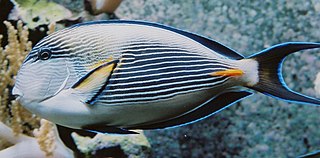
Acanthuridae are the family of surgeonfishes, tangs, and unicornfishes. The family includes about 86 extant species of marine fish living in tropical seas, usually around coral reefs. Many of the species are brightly colored and popular in aquaria.

The Moorish idol is a species of marine ray-finned fish belonging to the family Zanclidae. It is the only member of the monospecific genus Zanclus and the only extant species within the Zanclidae. This species is found on reefs in the Indo-Pacific region.

Zebrasoma is a genus of marine ray-finned fishes belonging to the family Acanthuridae which includes the surgeonfishes, unicornfishes and tangs. These fishes are found in the Indo-Pacific region.

Caproidae, or boarfishes, are a small family of marine fishes comprising two genera and 19 species. These fishes are found throughout the world in temperate and tropical seas.

Scatophagidae, the scats are a small family of ray-finned fishes in the order Perciformes. They are found in the Indo-Pacific region but one species has been introduced elsewhere.
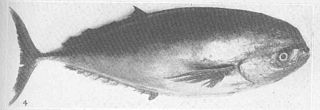
The louvar or luvar is a species of marine ray-finned fish, it is the only extant species in the genus Luvarus and family Luvaridae. This taxon is classified within the suborder Acanthuroidei, which includes the surgeonfish, of the order Acanthuriformes, and is the only pelagic species of this order. The juvenile form has a pair of spines near the base of the tail, like the surgeonfish, though they are lost in the adult.

Luvaridae is a family of marine ray-finned fishes belonging to the suborder Acanthuroidei in the order Acanthuriformes, of which they are the only pelagic members. The family has a single extant species, the widespread louvar and a small number of known extinct species.

Acanthuroidei, is a group of ray finned fishes which is a suborder of the Acanthuriformes, although it was regarded as a suborder of the Perciformes, the largest order of fish, in older classifications. The suborder includes the surgeonfish and Moorish idol. Members of this suborder have a compressed body covered with small ctenoid scales. The name for the suborder comes from that of the surgeonfish (Acanthuridae) family within it, and is derived from the Greek words akantha and oura, which loosely translate to "thorn" and "tail", respectively, referring to the "scalpels" found on surgeonfishes' caudal peduncle.

Ctenochaetus, or bristletooth tangs, is a genus of marine ray-finned fish belonging to the family Acanthuridae, which includes the surgeonfishes, unicornfishes and tangs. These fishes are found in the Indo-Pacific region. They have many, small flexible teeth and some species have the common name bristletooth.
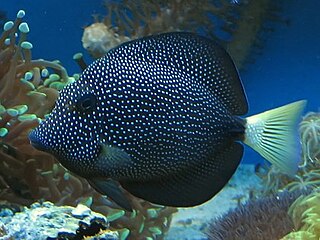
Zebrasoma gemmatum, the gem tang, jewelled tang, spotted tang or Mauritian tang, is a species of marine ray-finned fish belonging to the family Acanthuridae which includes the surgeonfishes, unicornfishes and tangs. This species is found in the Western Indian Ocean. The spotted tang is a highly prized specimen by marine aquarists and often commands high prices.
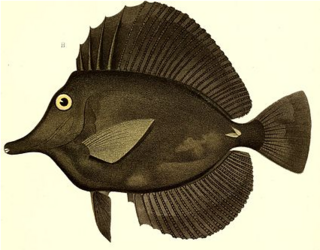
Zebrasoma rostratum, the longnose surgeonfish, longnose tang or black tang, is a species of marine ray-finned fish belonging to the family Acanthuridae, which includes the surgeonfishes, unicornfishes and tangs. This fish is found in the western central Pacific Ocean.

Zebrasoma scopas, the brown tang, twotone tang, scopas tang or brush-tail tang, is a species of marine ray-finned fish belonging to the family Acanthuridae which includes the surgeonfishes, unicornfishes and tangs. The brown tang is found throughout Oceania and is a herbivorous fish, feeding predominantly on filamentous algae. It is a highly popular fish in the aquarium trade.

The sailfin tang, the Pacific sailfin tang, purple sailfinned tang or sailfin surgeonfish, is a marine ray-finned fish belonging to the family Acanthuridae which includes the surgeonfishes, unicornfishes and tangs. This fish is found in the Pacific Ocean and is popular in the aquarium hobby.
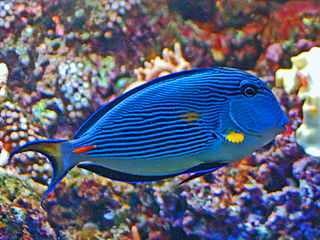
Acanthurinae is a subfamily of marine ray-finned fishes belonging to the family Acanthuridae, found in the Indo-Pacific and the tropical Atlantic. These fishes commonly have the English names surgeonfishes or tangs.

Cottoidei is a suborder of ray-finned fishes which, according to the 5th edition of Fishes of the World, is placed within the order Scorpaeniformes, alongside the scorpionfishes, flatheads, eelpouts, sticklebacks and related fishes.

Siganoidea is a superfamily belonging to the suborder Percoidei which in turn is the largest suborder of the order Perciformes. It contains two families of largely Indo-Pacific distribution.

Scorpaenini is a tribe of marine ray-finned fishes, one of two tribes in the subfamily Scorpaeninae. This tribe contains the "typical" or "true" scorpionfishes. The taxonomy of the scorpionfishes is in some flux, the 5th Edition of Fishes of the World treats this taxa as a tribe within the subfamily Scorpaeninae of the family Scorpaenidae within the order Scorpaeniformes, while other authorities treat it as a subfamily within a reduced family Scorpaenidae within the suborder Scorpaenoidei, or the superfamily Scorpaenoidea within the order Perciformes.

Moroniformes is an order of ray-finned fishes in the series Percomorpha.

Acanthurini is a tribe of marine ray-finned fishes belonging to the family Acanthuridae and it is one of three tribes in the subfamily Acanthurinae.

Zebrasomini is a tribe of marine ray-finned fishes belonging to the family Acanthuridae and it is one of three tribes in the subfamily Acanthurinae.




















